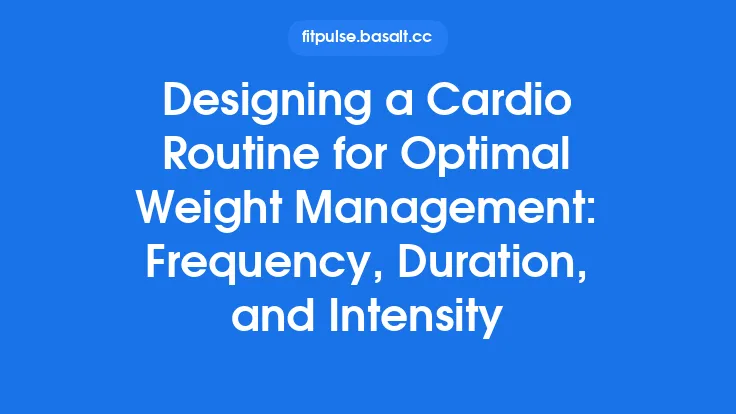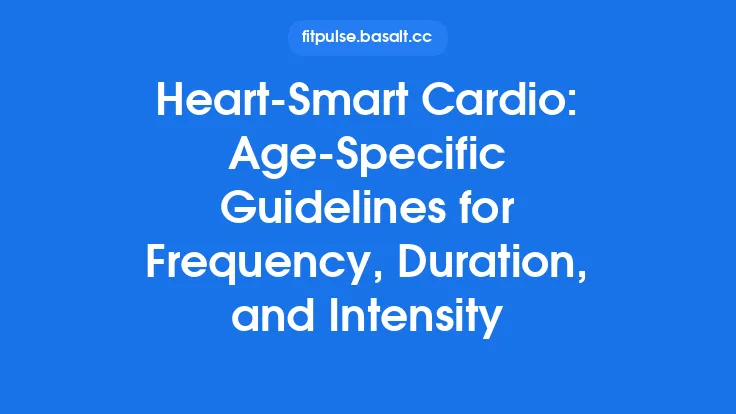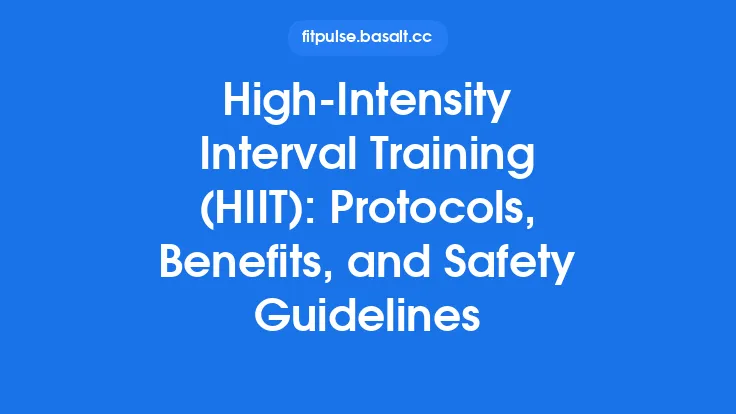Integrating high‑intensity interval training (HIIT) into a well‑rounded cardiovascular program requires more than simply sprinkling a few sprint intervals into a weekly schedule. The key lies in understanding how often the body can safely tolerate maximal efforts, what recovery strategies best support adaptation, and how to blend HIIT with other cardio modalities so that each session contributes to overall fitness without compromising health or performance.
Why Frequency Matters in a Balanced Cardio Program
HIIT elicits powerful acute stress on the cardiovascular and metabolic systems, triggering adaptations such as increased mitochondrial density, improved VO₂max, and enhanced anaerobic capacity. However, these adaptations are dose‑dependent: too few sessions may yield minimal gains, while too many can lead to chronic fatigue, diminished performance, and heightened injury risk.
- Acute stress vs. chronic adaptation – The physiological “shock” of a HIIT bout (elevated catecholamines, rapid lactate accumulation, and high heart‑rate peaks) must be followed by a period of super‑compensation, during which the body rebuilds stronger. The length of this window varies with training status, age, and lifestyle factors.
- Training load balance – In a balanced cardio routine, HIIT should complement, not replace, moderate‑intensity continuous training (MICT) and low‑intensity steady‑state (LISS) work. Each modality stresses different energy systems and recovery pathways, creating a synergistic effect when properly sequenced.
General Guidelines for Weekly HIIT Frequency
| Training Level | Recommended HIIT Sessions per Week | Typical Session Duration* | Example Weekly Layout |
|---|---|---|---|
| Beginner (≤ 6 months of regular cardio) | 1–2 | 10–20 min (including warm‑up & cool‑down) | Mon: HIIT 15 min → Wed: LISS 30 min → Fri: HIIT 15 min → Sun: MICT 45 min |
| Intermediate (6 months–2 years) | 2–3 | 15–25 min | Tue: HIIT 20 min → Thu: MICT 40 min → Sat: HIIT 20 min → Sun: LISS 45 min |
| Advanced (≥ 2 years, strong recovery capacity) | 3–4 | 20–30 min | Mon: HIIT 25 min → Wed: MICT 45 min → Fri: HIIT 25 min → Sat: HIIT 25 min (optional light LISS) |
\*Session duration includes a brief warm‑up (5 min) and cool‑down (5 min) but excludes any separate mobility work.
Key take‑aways
- Start low, progress gradually. Adding a single HIIT session per week to an existing cardio base is often sufficient for beginners to see measurable improvements.
- Avoid back‑to‑back HIIT days. A minimum of 48 hours between high‑intensity bouts allows phosphocreatine stores, glycogen, and neuromuscular function to recover.
- Listen to systemic fatigue. If you notice persistent soreness, elevated resting heart rate, or reduced performance in subsequent workouts, reduce HIIT frequency or insert an extra recovery day.
Structuring the Week: Integrating HIIT with Other Cardio Modalities
- Anchor Days – The “Base” Sessions
- LISS (Low‑Intensity Steady State): 30–60 min at 50–65 % of max heart rate (HRmax). Ideal for active recovery, promoting capillary density, and enhancing fat oxidation without taxing the nervous system.
- MICT (Moderate‑Intensity Continuous Training): 30–45 min at 65–75 % HRmax. Provides a cardiovascular stimulus that bridges the gap between LISS and HIIT, supporting aerobic endurance and serving as a “buffer” day after a HIIT session.
- HIIT Placement
- Post‑LISS/MICT: Performing HIIT after a moderate session can be useful for athletes seeking a “double‑dose” day, but only if the preceding session was low‑volume and the athlete has a solid recovery foundation.
- Standalone HIIT Days: Most common and safest approach—dedicate a full session to HIIT, allowing focused intensity and a clean recovery window afterward.
- Sample 7‑Day Cycle (Intermediate Level)
| Day | Session | Focus | Approx. HR% |
|---|---|---|---|
| Mon | HIIT (20 min) | Anaerobic power | 85–95 |
| Tue | LISS (45 min) | Active recovery | 50–60 |
| Wed | MICT (40 min) | Aerobic base | 65–75 |
| Thu | Rest or mobility | Full recovery | — |
| Fri | HIIT (20 min) | Anaerobic power | 85–95 |
| Sat | LISS (60 min) | Endurance & circulation | 50–60 |
| Sun | MICT (45 min) | Aerobic endurance | 65–75 |
Understanding Recovery: What the Body Needs After HIIT
1. Metabolic Recovery
- Glycogen Replenishment: HIIT heavily taxes muscle glycogen. Consuming 0.5–0.7 g of carbohydrate per kilogram of body weight within the first 30 minutes post‑session accelerates resynthesis.
- Protein Synthesis: Adding 20–30 g of high‑quality protein (e.g., whey, soy, or lean animal sources) within the same window supports muscle repair and mitochondrial remodeling.
2. Cardiovascular Recovery
- Heart‑Rate Variability (HRV): Monitoring HRV each morning can reveal autonomic balance. A significant drop (≥ 10 % from baseline) may signal insufficient recovery, suggesting a lighter cardio day or additional rest.
- Post‑Exercise Hypotension: A brief period of low‑intensity activity (5–10 min of walking) after HIIT helps normalize blood pressure and promotes venous return, reducing delayed onset muscle soreness (DOMS).
3. Neuromuscular Recovery
- Central Fatigue: High‑intensity efforts recruit fast‑twitch fibers and place stress on the central nervous system. Adequate sleep (7–9 h) and, when possible, short naps (20–30 min) are critical for restoring neural drive.
- Peripheral Fatigue: Light mobility work, foam rolling, or dynamic stretching can improve blood flow to fatigued muscles, expediting metabolite clearance.
4. Inflammatory Response Management
- Omega‑3 Fatty Acids: Regular intake (1–2 g EPA/DHA per day) has been shown to attenuate post‑exercise inflammation without blunting training adaptations.
- Antioxidant Timing: While antioxidants (vitamin C/E) can reduce oxidative stress, excessive dosing immediately after HIIT may interfere with signaling pathways responsible for adaptation. A balanced diet rich in whole‑food antioxidants (berries, leafy greens) is preferable.
Practical Recovery Tools for the Everyday Athlete
| Tool | How It Helps | Implementation Tips |
|---|---|---|
| Compression Garments | Improves venous return, reduces perceived muscle soreness | Wear for 30–60 min post‑HIIT or during low‑intensity recovery days |
| Cold‑Water Immersion (10–15 °C, 5–10 min) | Decreases acute inflammation, accelerates perceived recovery | Use sparingly (≤ 2 times/week) to avoid dampening long‑term adaptations |
| Active Recovery Sessions | Maintains circulation, clears lactate, supports HRV | 20 min of easy cycling or rowing at < 60 % HRmax on the day after HIIT |
| Sleep Hygiene Practices | Enhances hormonal milieu (growth hormone, cortisol) for repair | Consistent bedtime, dark room, limit screens 1 h before sleep |
| Periodical “Recovery Weeks” | Allows cumulative training stress to dissipate, preventing overreaching | Every 4–6 weeks, reduce HIIT frequency to 1 session and increase LISS/MICT volume |
Monitoring Progress and Adjusting Frequency
- Performance Metrics
- Time‑to‑Exhaustion (TTE) on a standard HIIT protocol – Track every 4–6 weeks. A plateau or decline may indicate insufficient recovery.
- Heart‑Rate Recovery (HRR) after a 1‑minute maximal effort – Faster HRR suggests improved autonomic balance.
- Subjective Measures
- Rate of Perceived Exertion (RPE) – If a typical HIIT session feels > 8 on a 10‑point scale consistently, consider adding a recovery day.
- Mood & Motivation – Persistent lack of enthusiasm or increased irritability can be early signs of overtraining.
- Adjusting the Plan
- If RPE rises +1–2 points for two consecutive sessions: Reduce HIIT frequency by one session for the next week, or replace a HIIT day with a longer LISS session.
- If HRV drops > 10 % for three days: Insert an extra rest day or replace the upcoming HIIT with a low‑intensity active recovery.
Special Considerations
Older Adults (≥ 60 years)
- Frequency: 1 HIIT session per week is often sufficient, paired with 2–3 days of moderate cardio.
- Recovery Emphasis: Prioritize joint mobility, adequate protein (1.2 g/kg), and longer sleep duration.
Athletes in Endurance Sports (e.g., runners, cyclists)
- Periodization: Use HIIT during “build” phases to boost VO₂max, then taper frequency 2–3 weeks before competition, focusing on MICT and race‑specific pacing.
Individuals with High Occupational Stress
- Recovery Buffer: Add an extra “recovery‑only” day (light walking, yoga) after each HIIT session to counteract systemic cortisol load.
Putting It All Together: A Blueprint for Sustainable HIIT Integration
- Assess Baseline Cardio Volume – Determine current weekly minutes of LISS/MICT.
- Select Initial HIIT Frequency – Based on training level, add 1–2 sessions per week, ensuring at least 48 hours between them.
- Schedule Complementary Sessions – Align LISS/MICT on non‑HIIT days, using them as active recovery or endurance work.
- Implement Recovery Protocols – Immediately post‑HIIT: carbohydrate‑protein snack, brief cool‑down, and optional compression. Follow with nightly sleep hygiene and weekly HRV check‑ins.
- Monitor & Adjust – Use RPE, HRV, and performance tests to fine‑tune frequency every 4–6 weeks.
By respecting the body’s need for metabolic, cardiovascular, and neuromuscular recovery, athletes can reap the potent benefits of HIIT—enhanced VO₂max, improved anaerobic capacity, and greater calorie burn—while maintaining a balanced, injury‑resistant cardio program. The result is a sustainable training rhythm that fuels long‑term health and performance.





